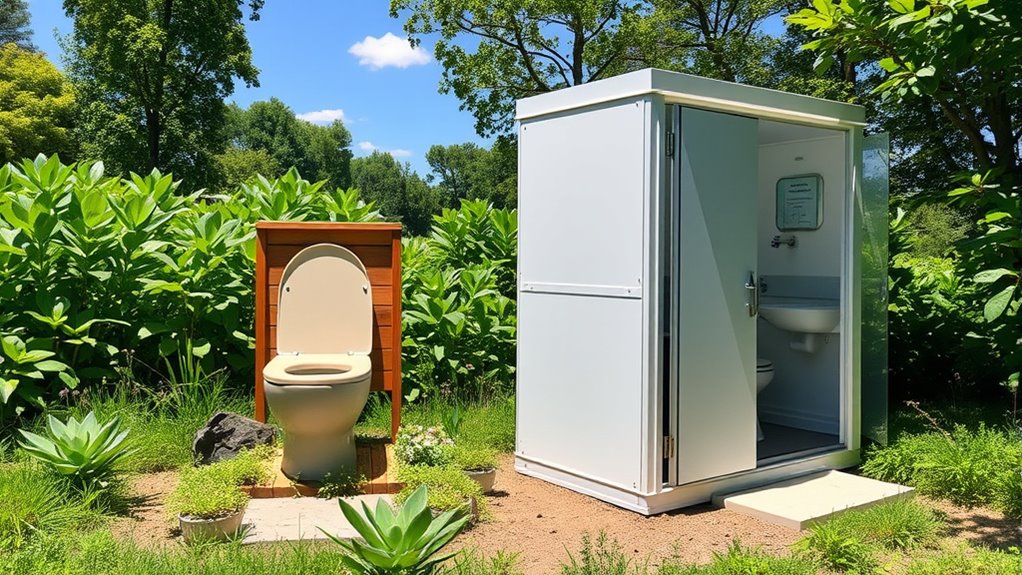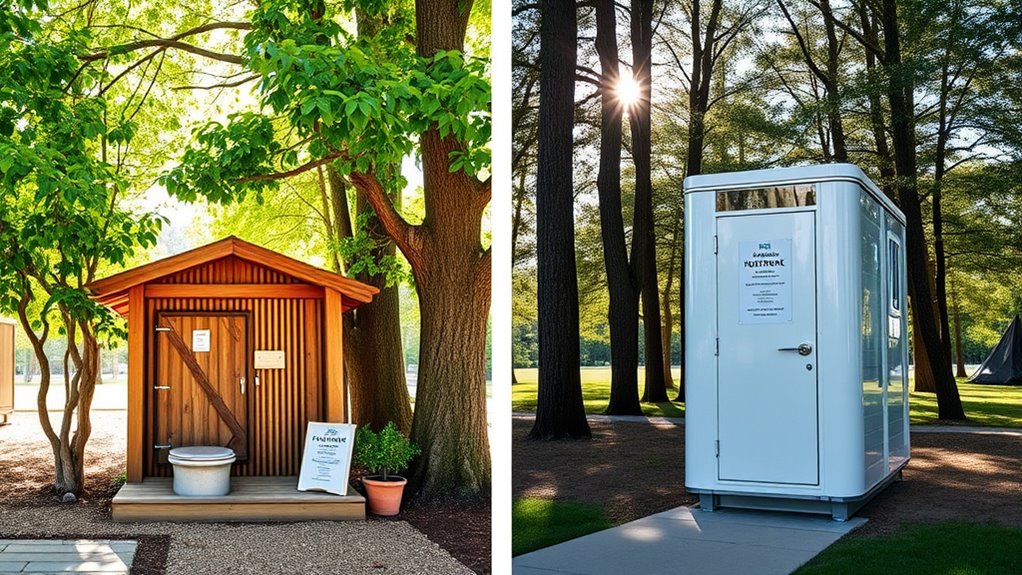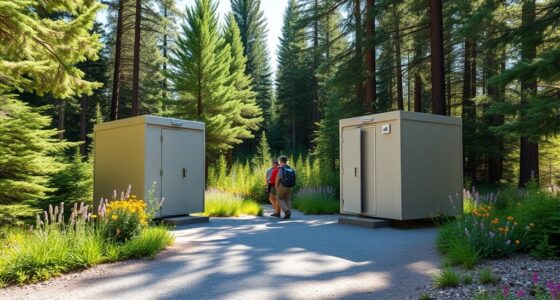When choosing between composting and flushable portable restrooms for your glampsite, consider your eco goals and infrastructure. Composting toilets are eco-friendly, water-saving, and require minimal infrastructure, making them ideal for remote or eco-conscious sites. Flushable restrooms provide familiar comfort but depend on plumbing and consume more water. Both options can align with sustainability if chosen thoughtfully—keep exploring to find the best fit for your unique setup.
Key Takeaways
- Composting toilets are eco-friendly, waterless, and produce soil-safe compost, ideal for sustainable, remote glampsites.
- Flushable restrooms offer familiar comfort but require plumbing and water, increasing infrastructure and maintenance costs.
- Composting toilets support water conservation and reduce reliance on sewage systems, aligning with eco-conscious goals.
- Flushable options provide convenience and guest comfort but may have higher environmental impact and setup complexity.
- The choice depends on site infrastructure, sustainability priorities, and guest experience preferences.

When choosing bathroom options for your glampsite, you face a key decision: should you opt for composting toilets or install flushable restrooms? Both choices have their merits, but understanding their environmental impact can help you make the best choice. Composting toilets are designed with eco-friendly materials that minimize their footprint. They use natural processes to break down waste, reducing reliance on water and sewage systems. This approach aligns with water conservation goals, as composting toilets typically require no water for flushing—making them ideal for remote or environmentally conscious sites. They also produce compost that can be safely used to enrich soil, adding a sustainable element to your glampsite.
Composting toilets minimize environmental impact with eco-friendly materials and no water use, perfect for sustainable glampsites.
On the other hand, flushable restrooms often utilize traditional plumbing systems that depend heavily on water. While modern models are more water-efficient, they still consume significant amounts, which can be a concern in areas where water is scarce or costly. Installing flushable toilets means you’ll need to connect to a sewage system or set up a septic tank, which involves more infrastructure and maintenance. If you prioritize water conservation, these options might seem less appealing, especially if your site emphasizes eco-friendly materials and sustainable practices. However, flushable restrooms tend to offer greater comfort and familiarity for guests, which can enhance their overall experience.
When weighing these options, consider how each aligns with your environmental values and the experience you want to provide. Composting toilets support water conservation efforts and reduce your reliance on infrastructure, making them a smart choice if sustainability is a top priority. They also appeal to eco-conscious travelers who appreciate low-impact accommodations. Conversely, if your guests expect the convenience and comfort of traditional restrooms, and you’re willing to invest in the necessary infrastructure, flushable restrooms might be more appropriate. Keep in mind that advancements in water-efficient models are narrowing the gap, but the core distinction remains their environmental impact.
Ultimately, your decision will depend on your site’s location, your sustainability goals, and the type of experience you want to create. Both options can be designed to meet eco-friendly standards, but composting toilets clearly excel in areas emphasizing water conservation and eco-conscious materials. Incorporating sustainable design practices can further enhance the eco-friendliness of your choice. Whichever choice you make, prioritizing environmentally responsible solutions will enhance your glampsite’s appeal and contribute positively to the environment.
Frequently Asked Questions
What Are the Initial Setup Costs for Composting Versus Flushable Restrooms?
You’ll find that composting toilets generally have lower initial setup costs, with installation expenses typically ranging from $500 to $3,000 per unit, depending on features. Flushable portable restrooms tend to have higher installation expenses, often between $2,000 and $7,000 each, due to plumbing and water connection requirements. The cost comparison shows composting options are more budget-friendly upfront, making them ideal if you want to minimize initial expenses.
How Do Maintenance Requirements Compare Between Composting and Flushable Systems?
They say “an ounce of prevention is worth a pound of cure,” and that’s true for maintenance. With composting systems, you’ll focus on odor control and user training to guarantee proper composting and minimal smell. Flushable restrooms require regular cleaning, water management, and checks on plumbing. Overall, composting needs more initial user education, while flushables demand consistent cleaning routines to keep everything running smoothly.
Which Option Has a Lower Environmental Impact Over Time?
You’ll find composting systems generally have a lower environmental impact over time because they use biodegradable materials and produce nutrient-rich compost, reducing waste. They also conserve water since they don’t rely on flushing. Flushable portable restrooms, while convenient, use more water and often involve chemicals that can harm the environment. Choosing composting options supports sustainability and minimizes your glampsite’s ecological footprint.
Are There Any Legal Restrictions for Installing Either System at Glampsites?
Think of installing restrooms like maneuvering a maze — you need to follow the signs to avoid dead ends. Yes, there are legal restrictions for both systems; you must guarantee legal compliance with local, state, and federal regulations. Regulatory hurdles can vary, so check zoning laws and waste management policies beforehand. Ignoring these rules might lead to fines or having to redo your setup, so do your homework early.
How Do Guest Preferences Influence the Choice Between These Sanitation Options?
Guest preferences play a big role in choosing between composting and flushable portable restrooms. You’ll find that guest comfort and privacy concerns influence their preferences—some favor flushable restrooms for familiarity and ease, while others prefer composting options for eco-friendliness. By considering what your guests value most, you can select a sanitation system that enhances their experience, ensuring they feel comfortable and secure during their stay.
Conclusion
Ultimately, choosing between composting and flushable restrooms is about honoring your glampsite’s harmony with nature. Think of it as selecting a gentle way to nurture your guests’ comfort while embracing eco-friendly practices. Each option offers a path that respects the land and preserves its beauty. Whichever you choose, you’re making a quiet, meaningful gesture—one that leaves a soft, lasting impression on the earth and your visitors alike.









